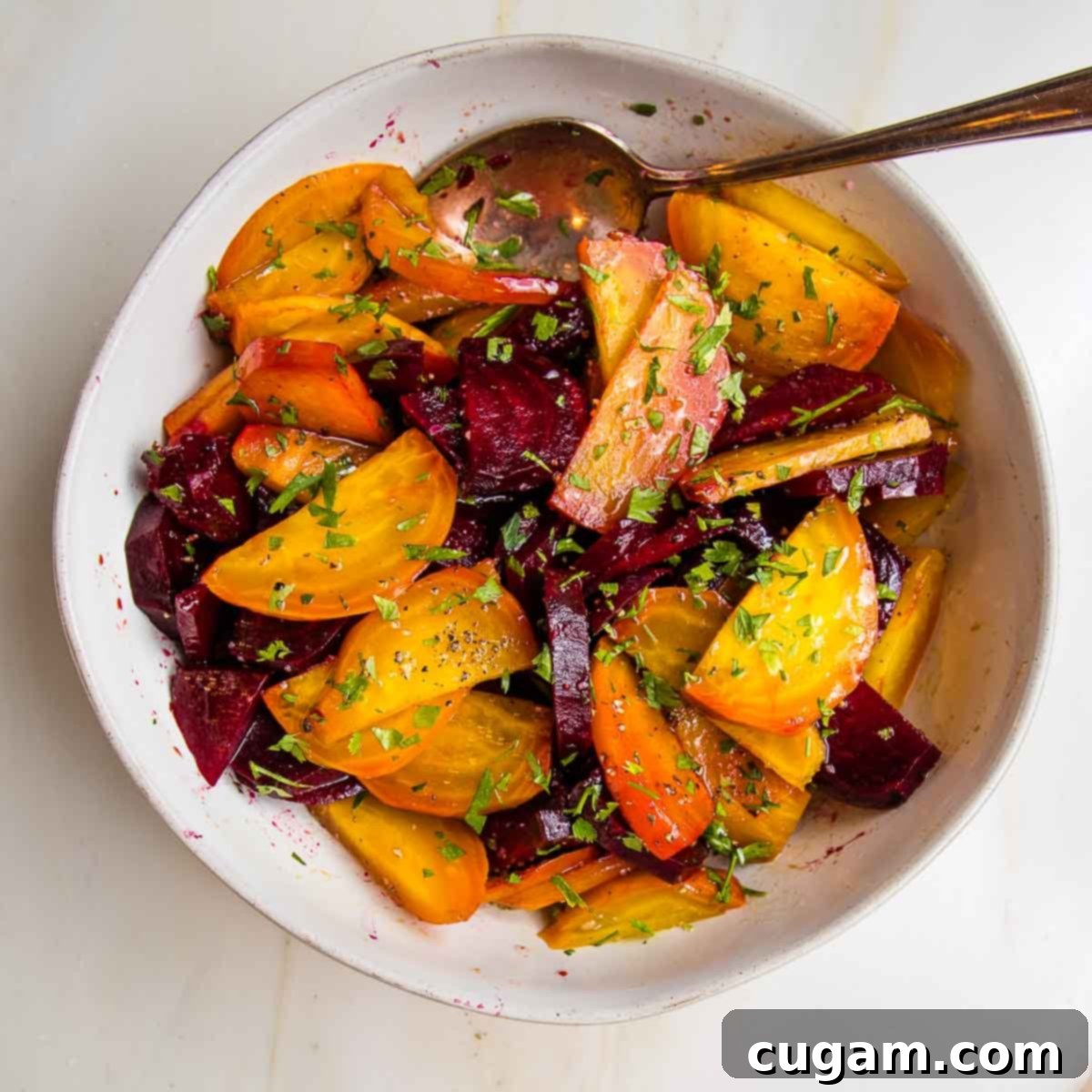The Best Whole Roasted Beet Salad with Balsamic Vinaigrette (Cheese-Free)
If you’re a beet enthusiast searching for an incredibly easy and flavorful Beet Salad Recipe without Cheese, you’ve found your new favorite! This delightful Whole Roasted Beet Salad with Balsamic Vinaigrette isn’t just a simple side dish; it’s a vibrant, healthy addition that perfectly complements any meal. Its natural sweetness, earthy notes, and tangy dressing create a symphony of flavors that will truly impress.
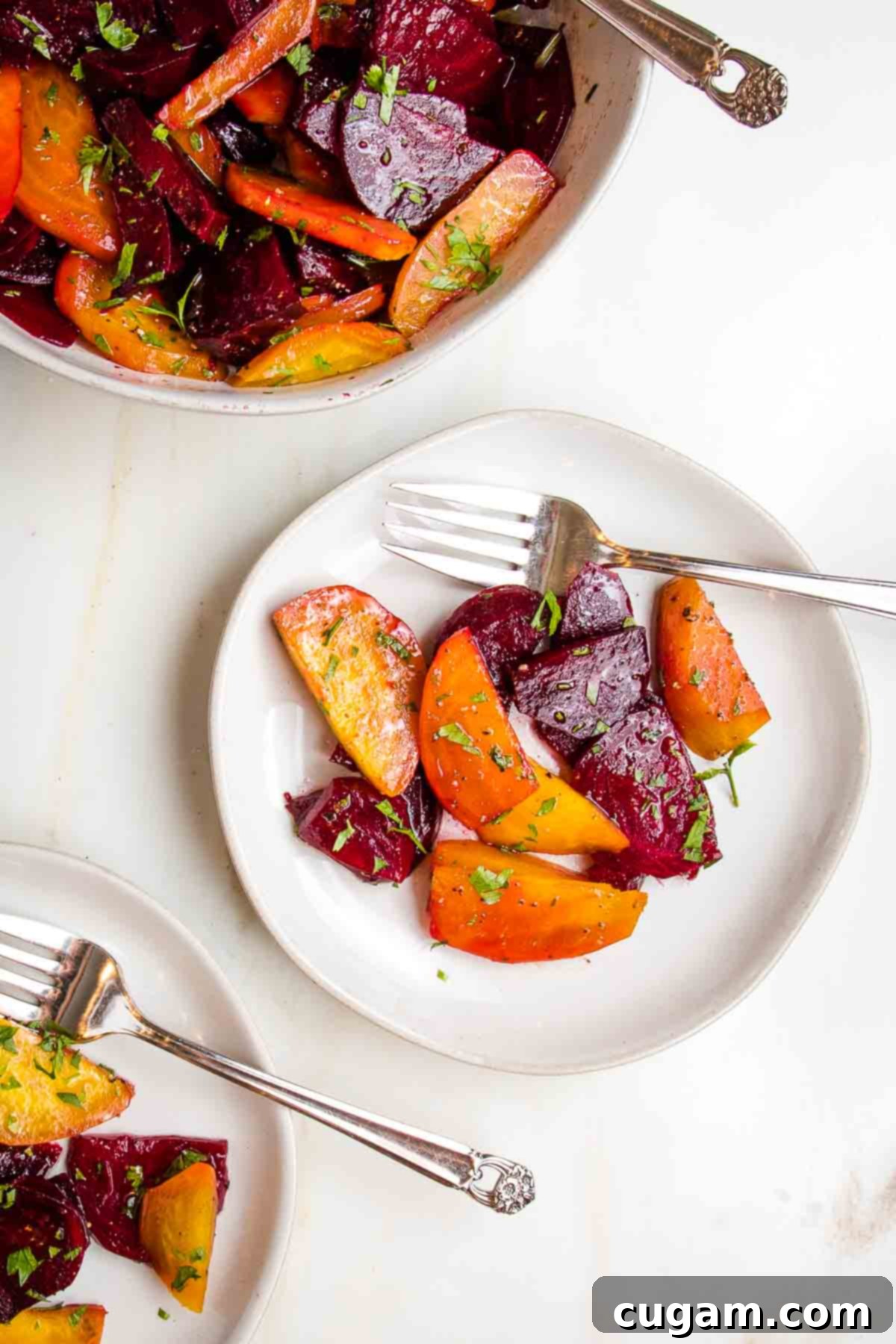
This post was updated from the original dated June 21, 2016, to provide even more detailed instructions, tips, and nutritional insights.
Roasted beet salad is a true culinary gem—tasty, naturally sweet, and absolutely gorgeous! Roasting root vegetables, especially beets, intensifies their inherent sweetness and deepens their flavors, making them an irresistible treat. Beets are incredibly versatile; you can even blend a few into your low-carb hummus for a stunning pop of color and an extra nutritional boost.
My absolute favorite and most recommended way to cook beets for this salad is to roast them whole. This method is incredibly easy and fuss-free, whether you’re working with golden beets or classic red beets. Say goodbye to messy, stained hands and the need for a vegetable peeler! Once roasted whole, the skins practically slip right off with minimal effort. This allows you to effortlessly cut them into any shape and size you desire, and then dress them to perfection.
When it comes to beet recipes, this balsamic beets recipe stands out. It’s a literal “flavor bomb”—the deep, earthy sweetness of the roasted beets beautifully juxtaposed with the bright acidity of the balsamic vinaigrette creates a dreamy combination that beet lovers will adore. It’s a simple yet sophisticated dish that highlights the best of what beets have to offer.
Understanding and Appreciating Beets
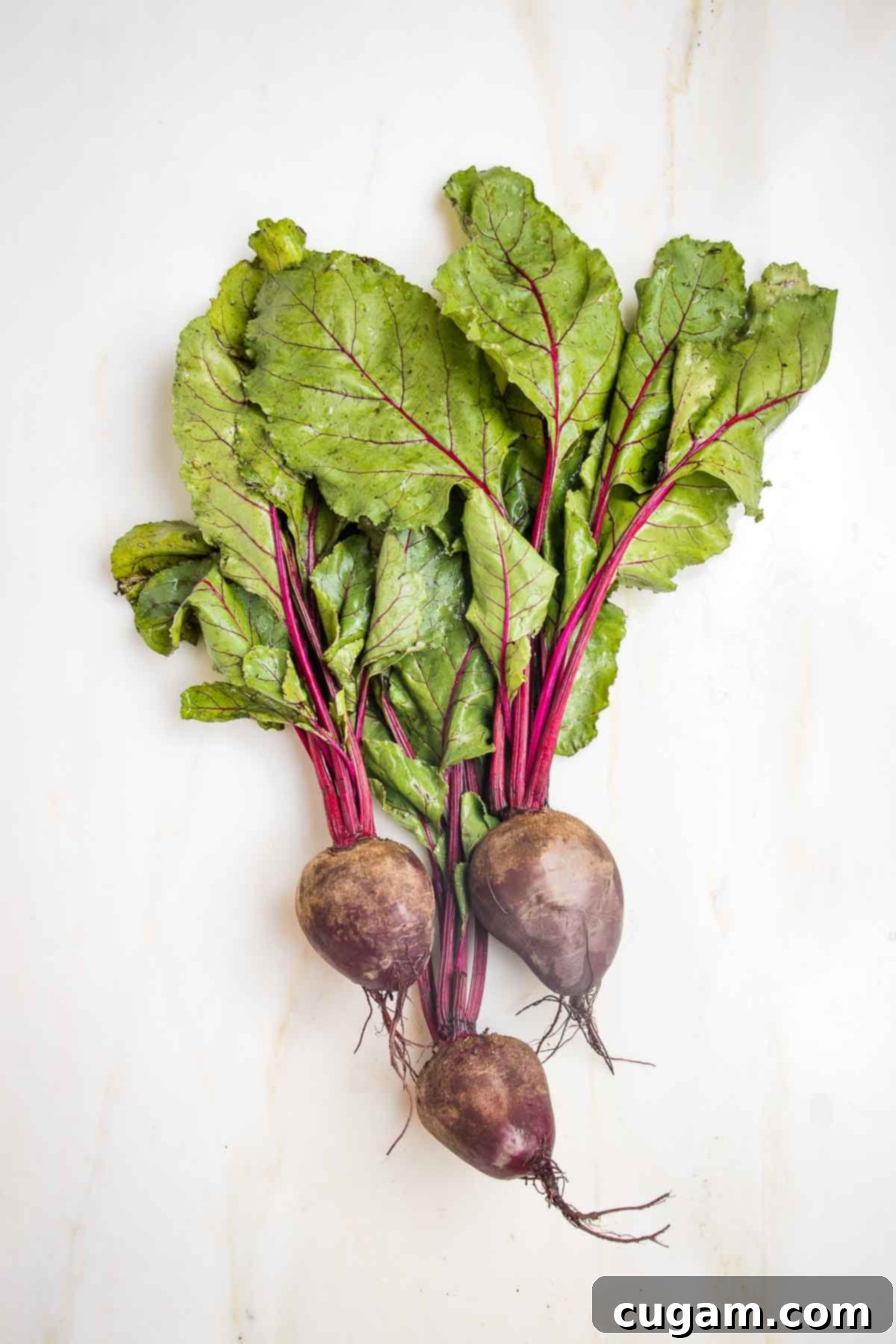
Beets are not just delicious; they are also packed with essential nutrients, making them a fantastic addition to any healthy diet. They are an excellent source of fiber, folate (vitamin B9), manganese, potassium, iron, and vitamin C. The vibrant colors of beets come from betalains, powerful antioxidants that have anti-inflammatory properties. Incorporating beets into your meals can support heart health, aid in digestion, and even boost athletic performance.
There are several varieties of beets, each with its own unique characteristics:
- Red Beets: The most common variety, known for their deep, earthy flavor and intense ruby-red color. They are excellent for roasting and add a dramatic hue to any dish.
- Golden Beets: These have a milder, sweeter flavor profile and a beautiful golden-yellow color. They don’t bleed like red beets, making them a great choice for salads where you want to maintain distinct colors.
- Chioggia Beets (Candy Stripe Beets): With their striking red and white concentric rings, these beets offer a slightly milder sweetness and an eye-catching appearance, especially when sliced.
Different Methods for Roasting Whole Beets: A Detailed Guide
Roasting beets whole is the secret to their incredible flavor and easy preparation. It locks in moisture, concentrates their sweetness, and makes peeling a breeze. Here’s a more in-depth look at various tried-and-true methods:
- Instant Pot Beets: This method is a game-changer when you’re short on time. Using your pressure cooker is an incredibly efficient way to cook whole beets. They come out perfectly tender, retaining their vibrant color and natural sweetness in a fraction of the time compared to oven roasting. Definitely a thumbs up for quick and reliable results.
- Dutch Oven: A heavy-bottomed, covered baking dish like a Dutch oven is an excellent choice for achieving beautifully oven-roasted whole beets without the need for aluminum foil. The heavy lid creates a sealed environment, allowing the beets to steam and roast simultaneously, resulting in a wonderfully tender interior and slightly caramelized exterior. This method ensures even cooking and prevents the beets from drying out.
- Baking Dish with Parchment & Foil: For those without a Dutch oven, a shallow baking dish can work wonders. Arrange the beets in a single layer at the bottom. The trick here is to wet a piece of parchment paper, crumple it up to squeeze out excess water, then unfold and lay this damp parchment directly over the beets. This creates a moist barrier before you seal the dish tightly with a layer of aluminum foil. This technique mimics the steaming effect of a Dutch oven, ensuring tender, perfectly cooked beets.
- Foil Packet Roasting (with a twist): While wrapping beets directly in foil is common, I’m not a fan of direct contact between food and aluminum. However, you can use this method safely by first wrapping each beet in a small piece of parchment paper, and *then* enclosing it in an aluminum foil packet. Place these individual packets on a rimmed baking sheet. The foil pouch effectively traps hot air, allowing the beets to steam gently inside, while the parchment paper prevents any aluminum leaching.
No matter which method you choose, the goal is always tender, sweet beets that are easy to peel and prepare for your vibrant salad.
Key Ingredients for an Unforgettable Beet Salad
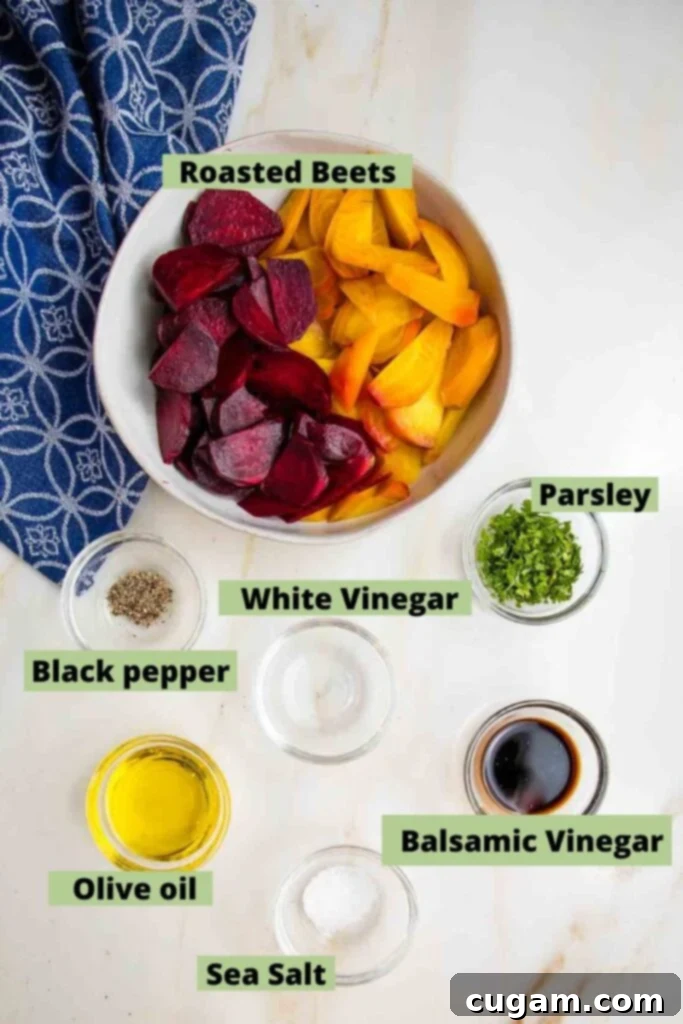
The beauty of this roasted beet salad lies in its simplicity and the quality of its components. Each ingredient plays a crucial role in balancing the flavors:
- Beets: As discussed, a combination of golden beets and red beets offers both visual appeal and a subtly nuanced flavor profile. Roasting beets whole is key here, as it helps them retain their maximum nutritional value, vibrant color, and firm-yet-tender texture. Just like with my whole roasted cauliflower, whole roasting makes all the difference!
- Extra Virgin Olive Oil: A good quality extra virgin olive oil is essential. It not only enhances the natural flavors of the roasted beets, transforming them into a luxurious salad, but also provides healthy monounsaturated fats. These fats are crucial for the better absorption of fat-soluble vitamins found in beets, such as vitamin A, making your salad even more nutritious.
- Vinegar: The dressing’s magic comes from a precise combination of white vinegar and balsamic vinegar. The white vinegar provides a sharp, clean acidity that brightens the dish, while the balsamic vinegar adds a complex, slightly sweet, and rich tang. This balance perfectly cuts through the sweetness of the beets. For a lighter color and milder flavor, you can also opt for white balsamic vinegar.
- Fresh Herbs: Fresh parsley is my herb of choice for this salad. It adds a pop of fresh, herbaceous flavor, a beautiful green contrast, and a significant nutritional boost, providing potassium and vitamins A, K, and C. If parsley isn’t your preference or available, fresh basil, oregano, or thyme would also make wonderful substitutes, each offering a slightly different aromatic note.
- Seasoning: Sometimes, less is more. A simple sprinkle of coarse sea salt and freshly ground black pepper is all that’s needed to elevate the flavors of this beet salad to an incredible level. The salt enhances the sweetness of the beets, while the pepper adds a subtle warmth and bite. Remember to taste and adjust the seasoning to your personal preference.
These core ingredients, when combined, create a harmonious and deeply satisfying salad that is both wholesome and gourmet.
How to Roast Beets Whole for an Exquisite Salad
Preparing roasted beetroot for your salad is incredibly straightforward when you employ my whole beet roasting method. While this recipe focuses purely on beets, the finished product would also be fantastic tossed with peppery arugula, robust kale, or even the beet greens themselves for an extra layer of flavor and nutrition. If you’re a true beet enthusiast, you might also enjoy my Roasted Squash and Beet Salad.
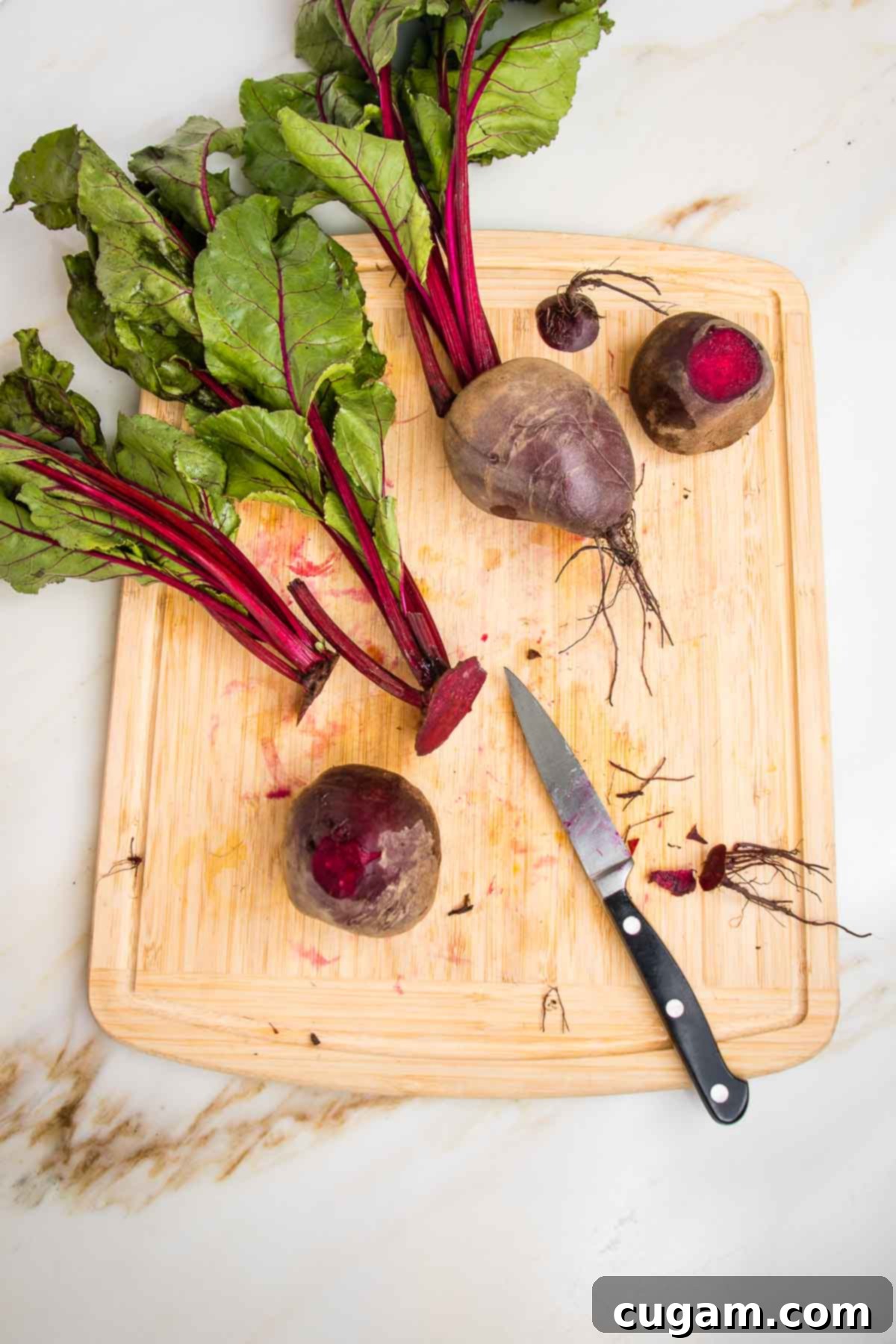
The first crucial step is to prepare your beets properly. I highly recommend using a pair of kitchen gloves at this stage, especially when handling red beets, to prevent their vibrant pigments from staining your hands. Red beet juice can be quite persistent!
Using a sharp paring knife, carefully trim off the beet greens and stems from the top of each beet, leaving about an inch of stem attached to prevent excessive bleeding during cooking. Also, trim the root end slightly so that the beets can sit flat and cook evenly. Don’t discard those beautiful beet greens and stems! They are incredibly nutritious and can be set aside for another delicious use. Fresh beet greens will stay good in the fridge for about 2 days.
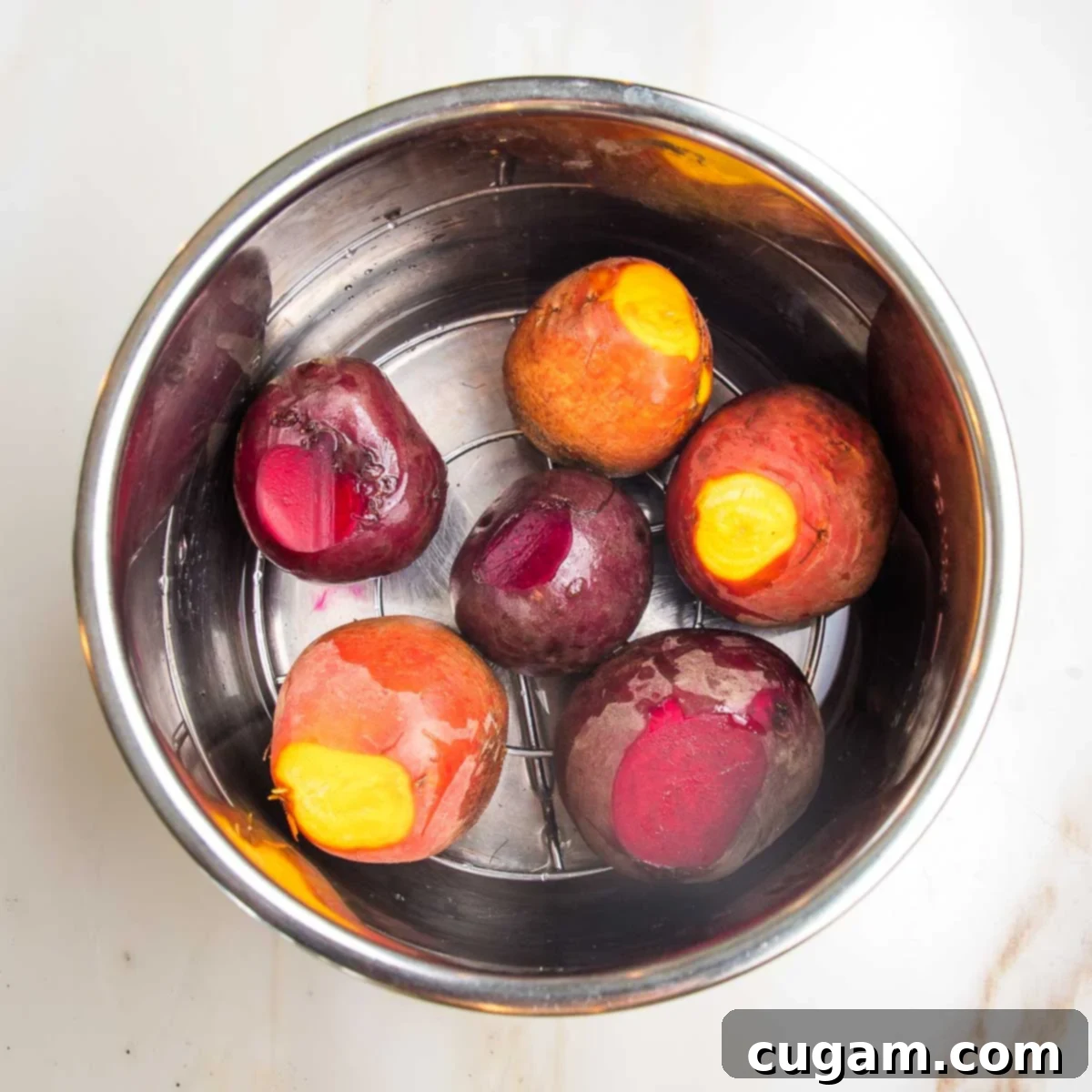
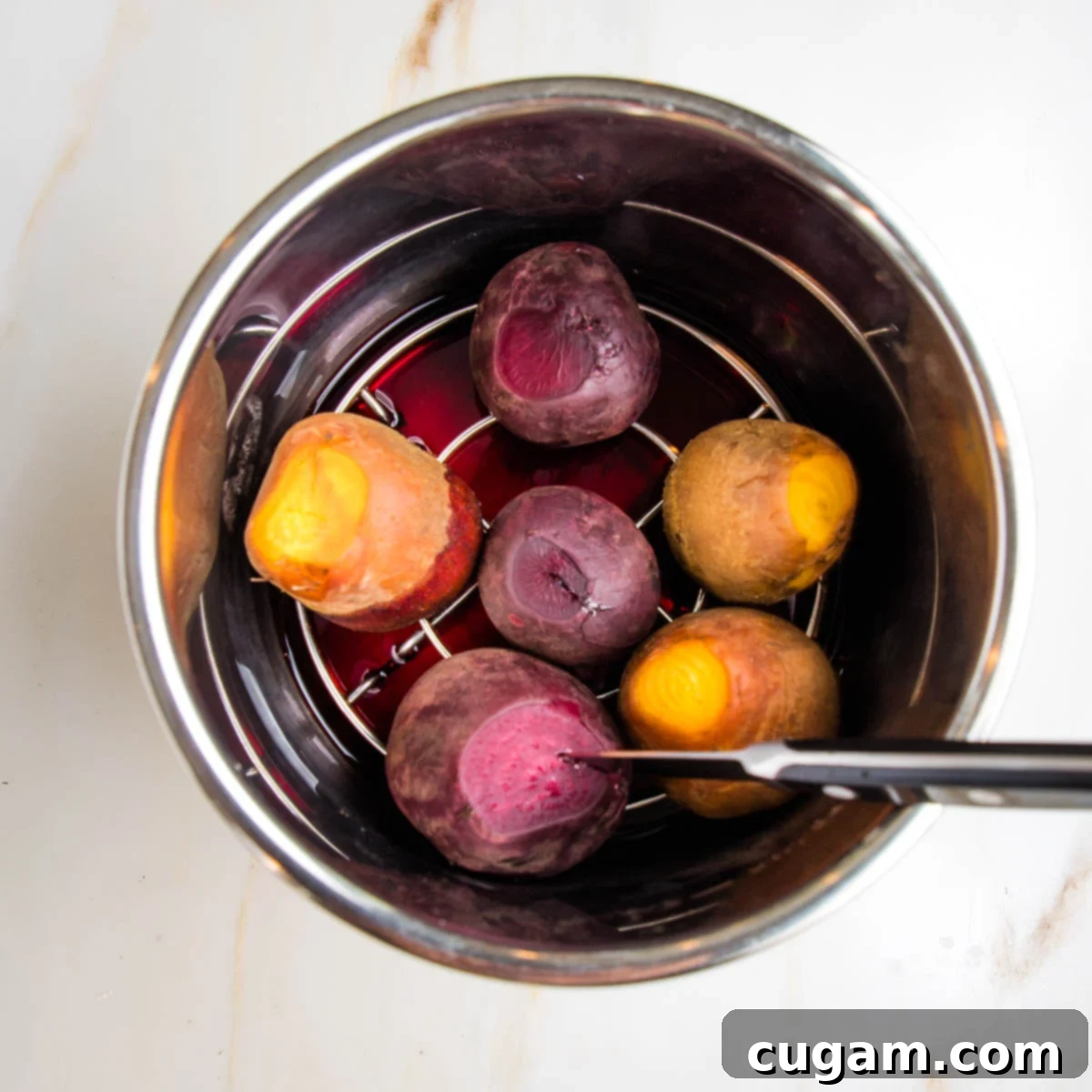
For Instant Pot Beets: Once trimmed, place the whole beets on the rack inside your Instant Pot. Pour in 1 cup of water, ensuring it’s below the rack level. Secure the lid and seal the valve. For medium-sized beets, cook on high pressure for 15 minutes. Once cooking is complete, use the quick release method for the pressure. Beets should be tender enough to allow a paring knife to slip in with very little resistance. For larger beets (golf ball to tennis ball size), add an additional 3-4 minutes to the cooking time. Even larger beets might require up to 20 minutes on high pressure to achieve perfect tenderness.
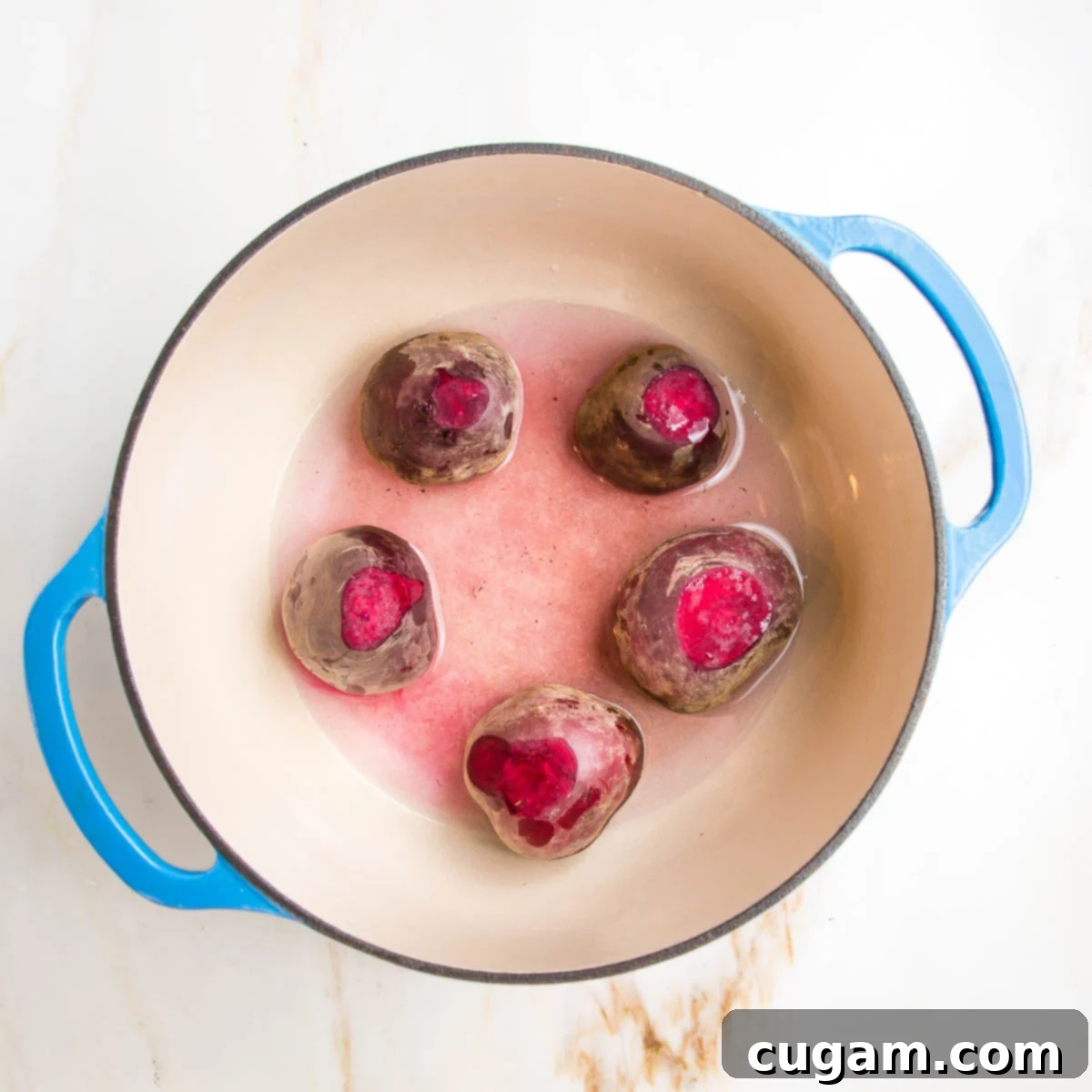
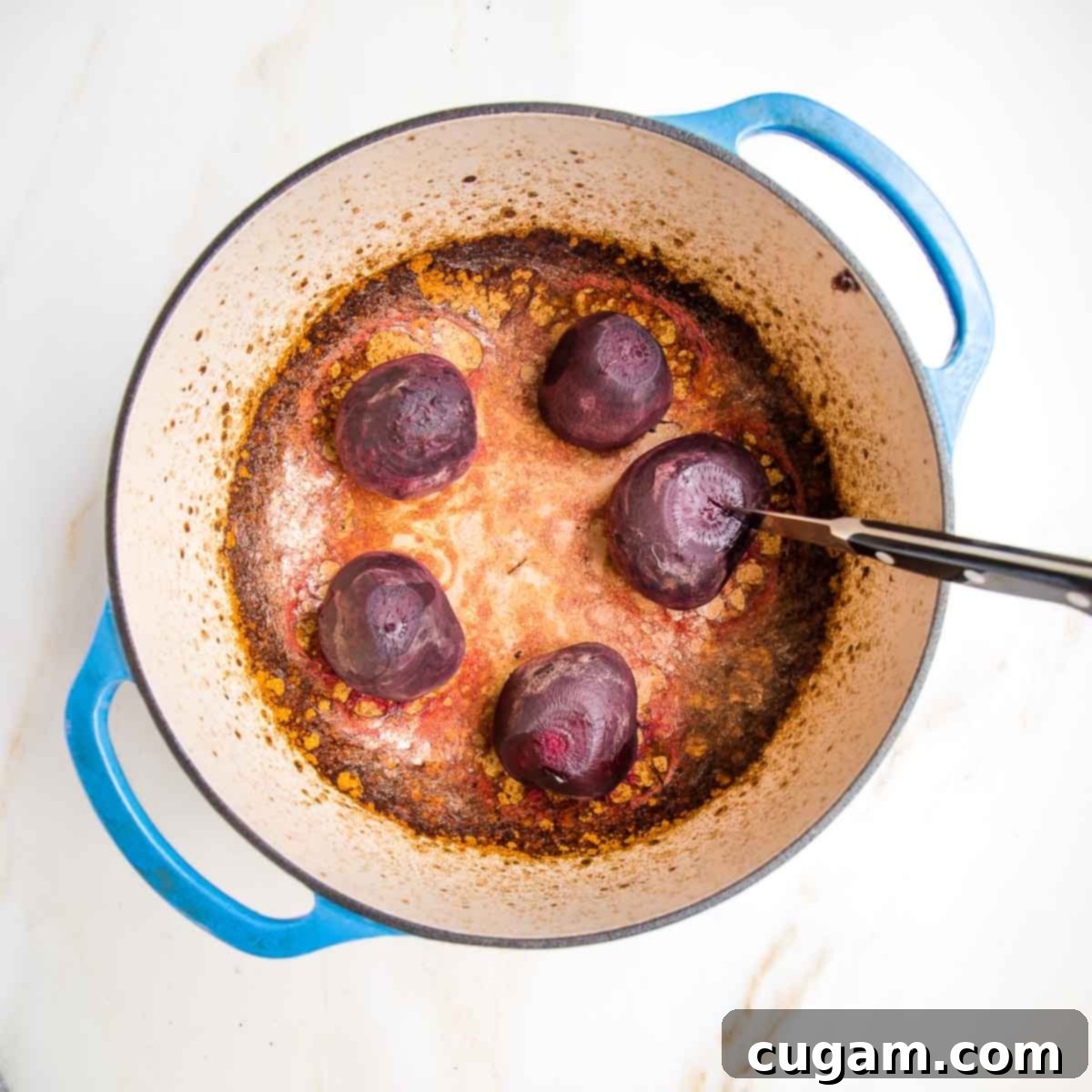
Dutch Oven Whole Roasted Beets: Preheat your oven to 425°F (220°C). Place the trimmed beets in a single layer on the bottom of your Dutch oven. Add about 1 inch of water to the pot. Cover tightly with the lid. Roast medium-sized beets for approximately 1 hour. For specific timing adjustments based on beet size, refer to the detailed chart below or the recipe card. This method creates a steamy environment that yields incredibly tender beets with a lovely, slightly caramelized exterior.
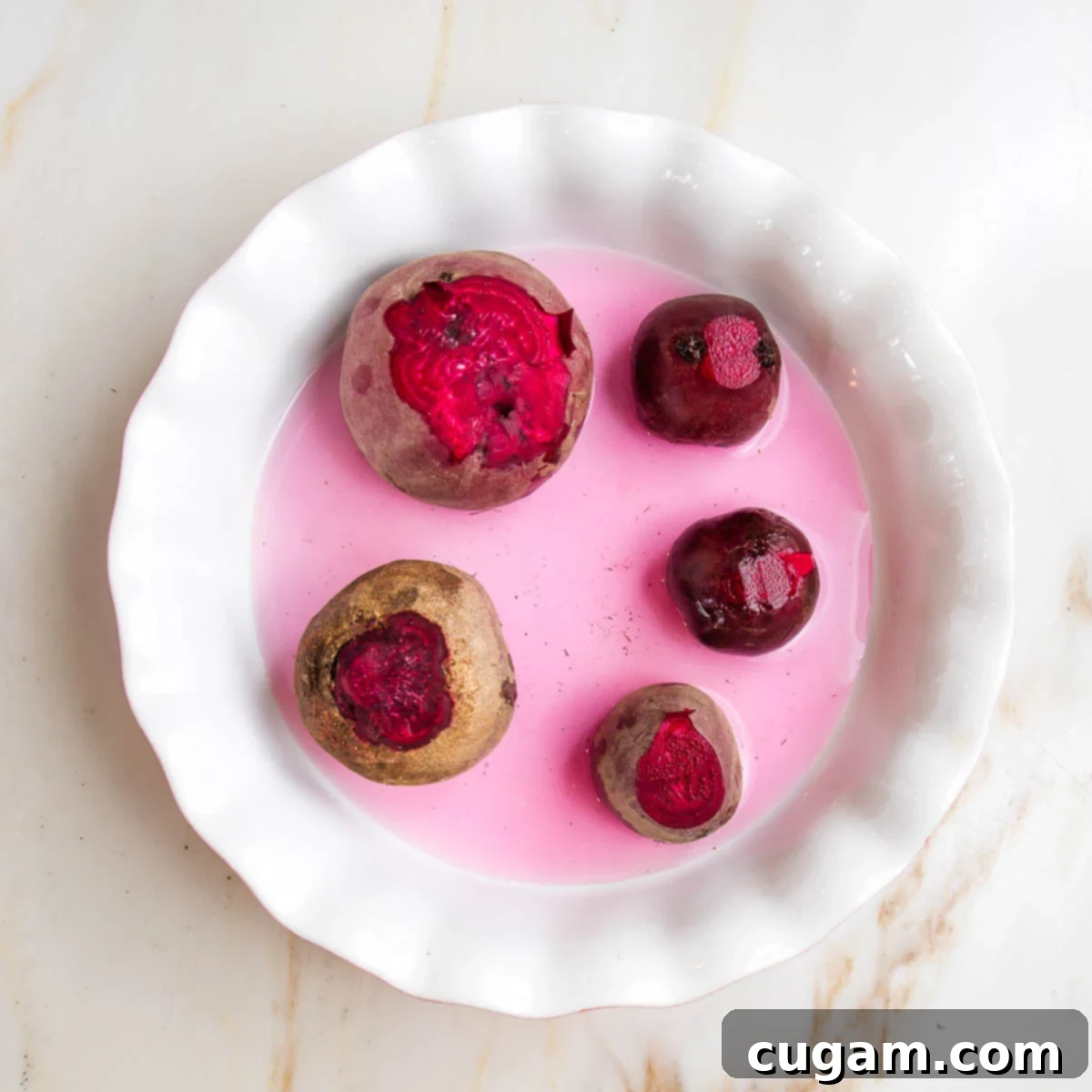
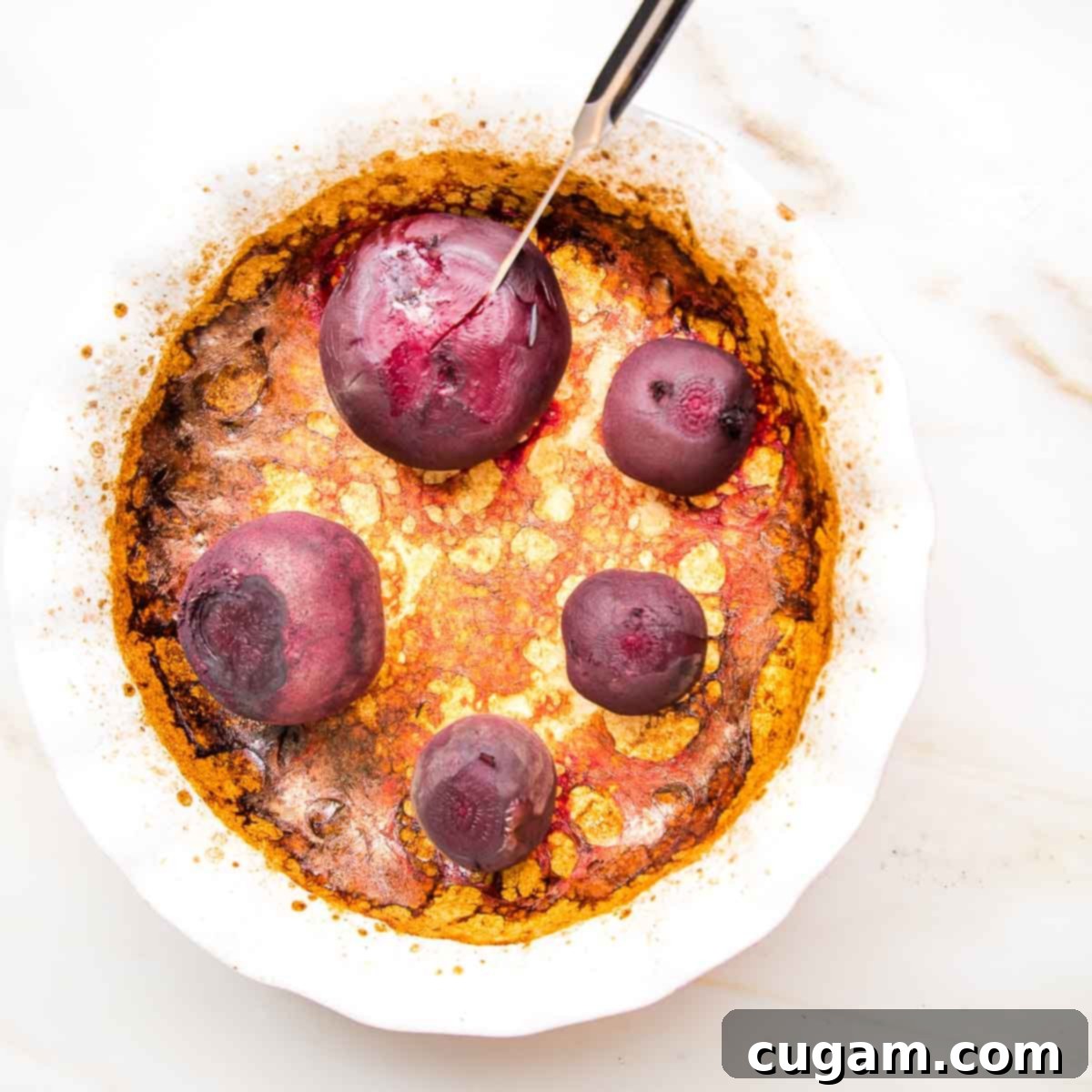
Whole Roasted Beets in a Baking Pan: Preheat your oven to 425°F (220°C). Arrange the trimmed beets in a single layer in a shallow baking dish. Add about 1 inch of water to the dish. To create a moist environment, take a piece of unbleached parchment paper, wet it thoroughly, then crumple it and squeeze it dry. Unfold the wrinkled, slightly damp parchment and lay it directly over the beets. Finally, cover the baking dish tightly with aluminum foil to seal in the steam. Place the covered baking dish in the preheated oven and roast medium-sized beets for approximately 1 hour. For larger beets, you might need to add an additional 15 minutes of roasting time.
How Long to Cook Whole Beets for Perfect Tenderness
NOTE: Beets are perfectly cooked when they are tender to the tines of a fork or can be easily pierced with a paring knife. For a beet salad, you want them tender but not mushy, as they still need to hold their shape when sliced. Always check for doneness at the suggested times and adjust as needed.
- Pressure Cooker Beets: Place trimmed beets on the rack and add one cup of water to the Instant Pot. Cook on high pressure for 15 minutes for medium-sized beets. Adjust the cooking time by 3-4 minutes (plus or minus) for smaller or larger beets, respectively. Use quick release for pressure.
- Dutch Oven Roasted Beets or Beets Baked in a Baking Dish: Arrange beets in a single layer and add about 2 inches of cool water to the bottom of the dish. Seal tightly with the lid of the Dutch oven or cover the baking dish with a damp piece of parchment paper, then tightly seal with aluminum foil. Cook in a preheated 425°F (220°C) oven for 1 hour for medium-sized beets. Add 10 minutes for large beets and an additional 20 minutes for extra-large beets.
- Roasted Beets in Foil Packets: Cut a piece of aluminum foil large enough to fully encase each individual beet. Then, place a piece of parchment paper onto the beet before wrapping it. Lay the beet onto the parchment. Individually wrap each trimmed whole beet in this parchment-lined foil packet and place them on a sheet pan. This method ensures the beets do not come into direct contact with the aluminum. Roast in a 400°F (200°C) preheated oven for approximately 45 minutes if the beets are small. Beets are done when tender to the tines of a fork. Add 10 minutes for medium-sized beets, and larger beets could take as long as 1 hour and 15 minutes.
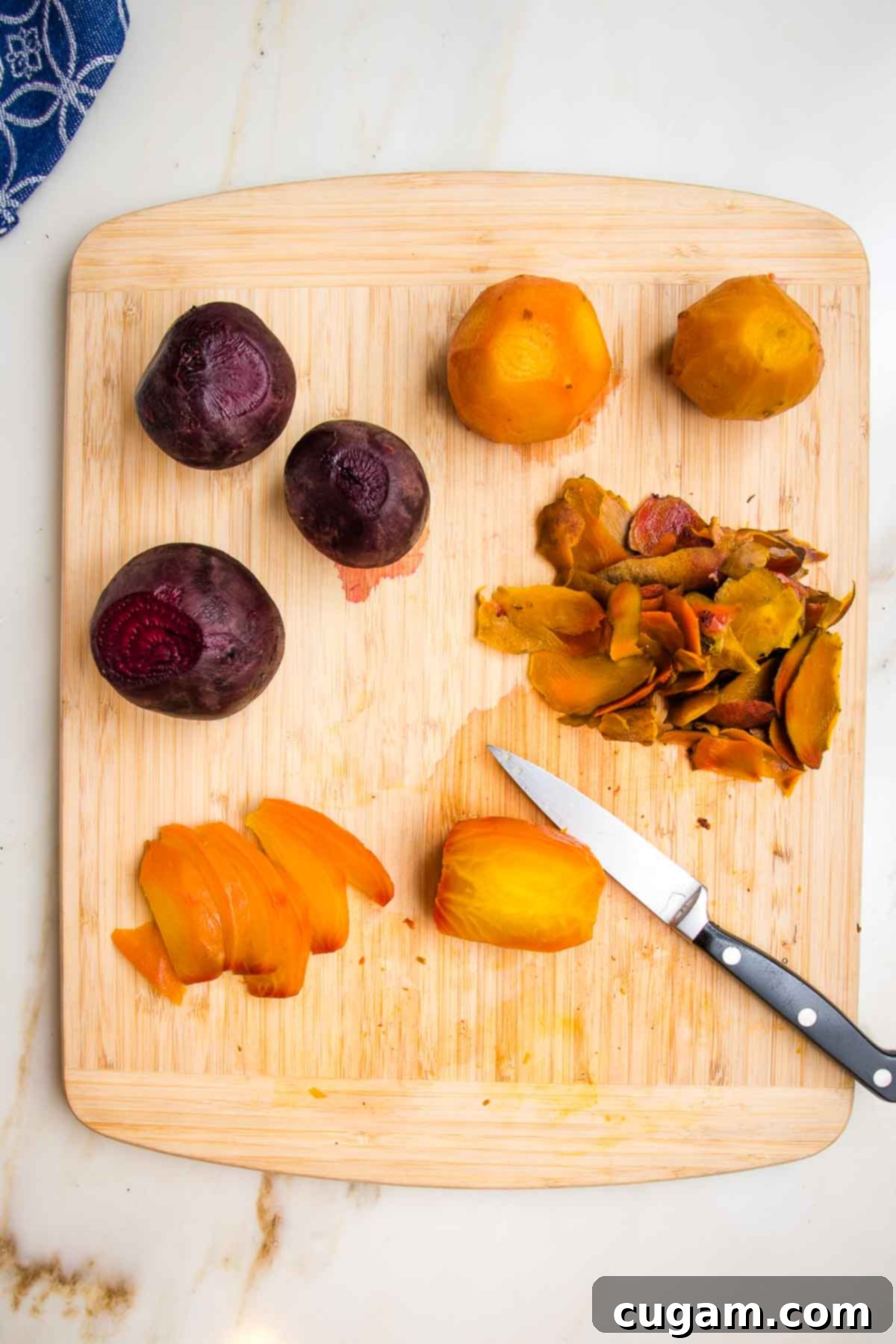
Once the beets are cooked, allow them to cool down just enough so they are comfortable to handle. Transfer the cooked whole beets to a cutting board. The beauty of roasting beets whole is how incredibly easy they are to peel! You can simply use a paper towel to rub the papery outer skin right off—it practically slides away. Alternatively, a small paring knife can be used to gently remove the outer skin, especially if you want a cleaner finish. Remember to still use gloves if you’re sensitive to beet stains!
After peeling, cut each beet in half, then proceed to cut them into elegant wedges or bite-sized cubes, depending on your preference for the salad’s presentation and texture.
Place the freshly roasted and sliced beets into a medium-sized bowl. While the beets are still warm, drizzle them generously with extra virgin olive oil, balsamic vinegar, and white vinegar. This ensures that the warm beets absorb all the beautiful flavors of the dressing. Sprinkle with coarse sea salt, freshly ground black pepper, and the finely chopped fresh parsley. Mix everything well to ensure all the beet pieces are evenly coated. Finally, taste for seasoning, adding any additional salt and pepper to your personal taste until the flavors are perfectly balanced.
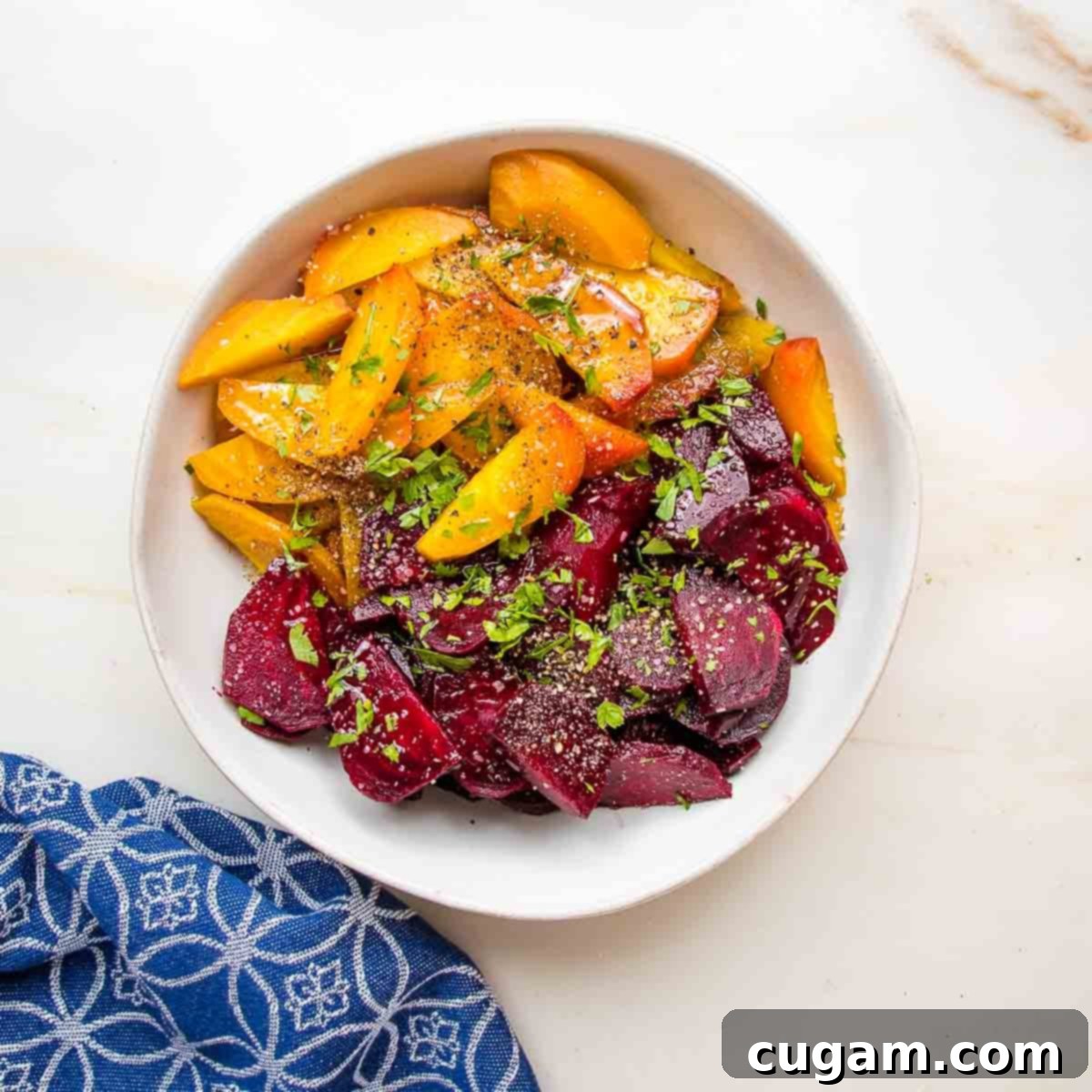
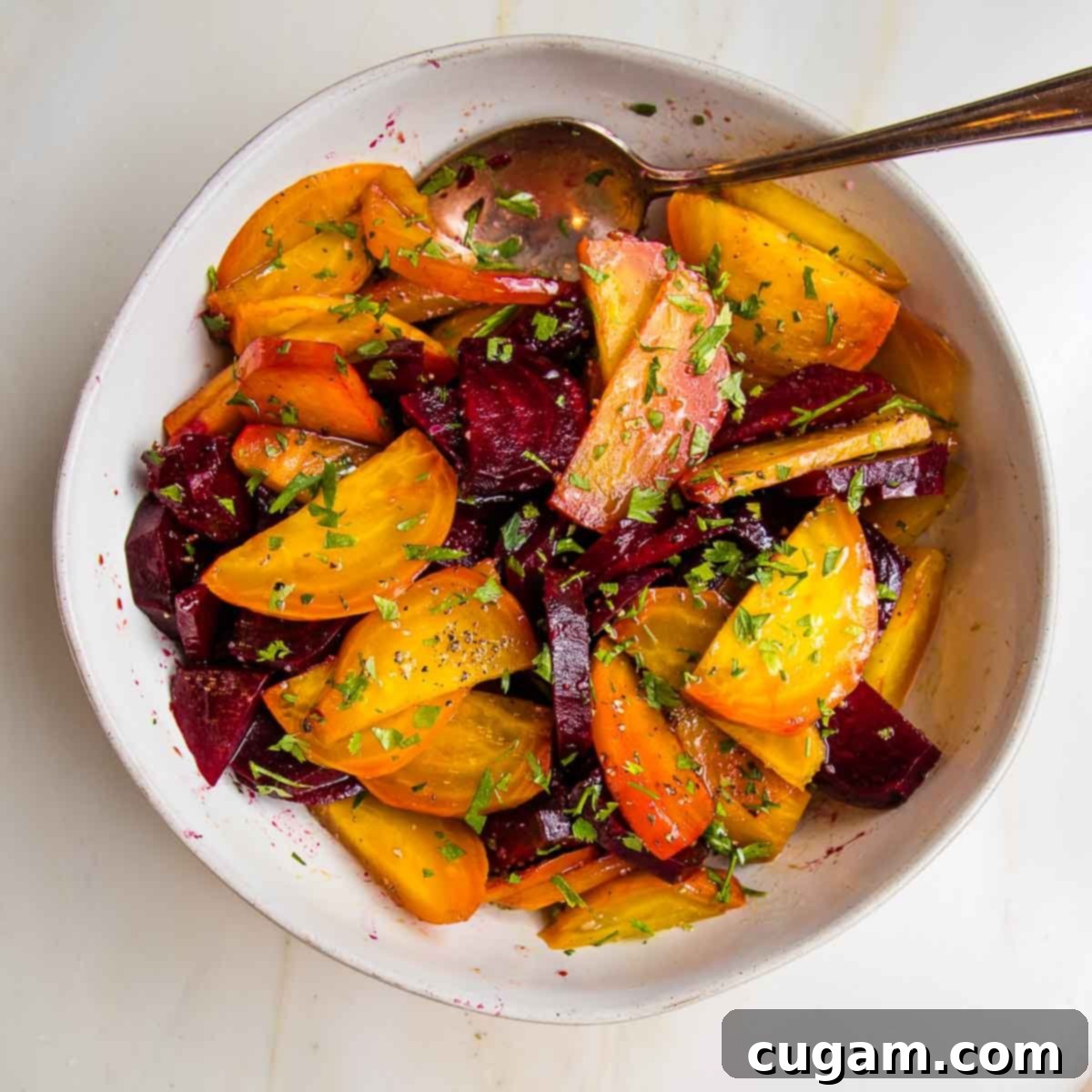
Debra’s Pro Tips for Beet Perfection
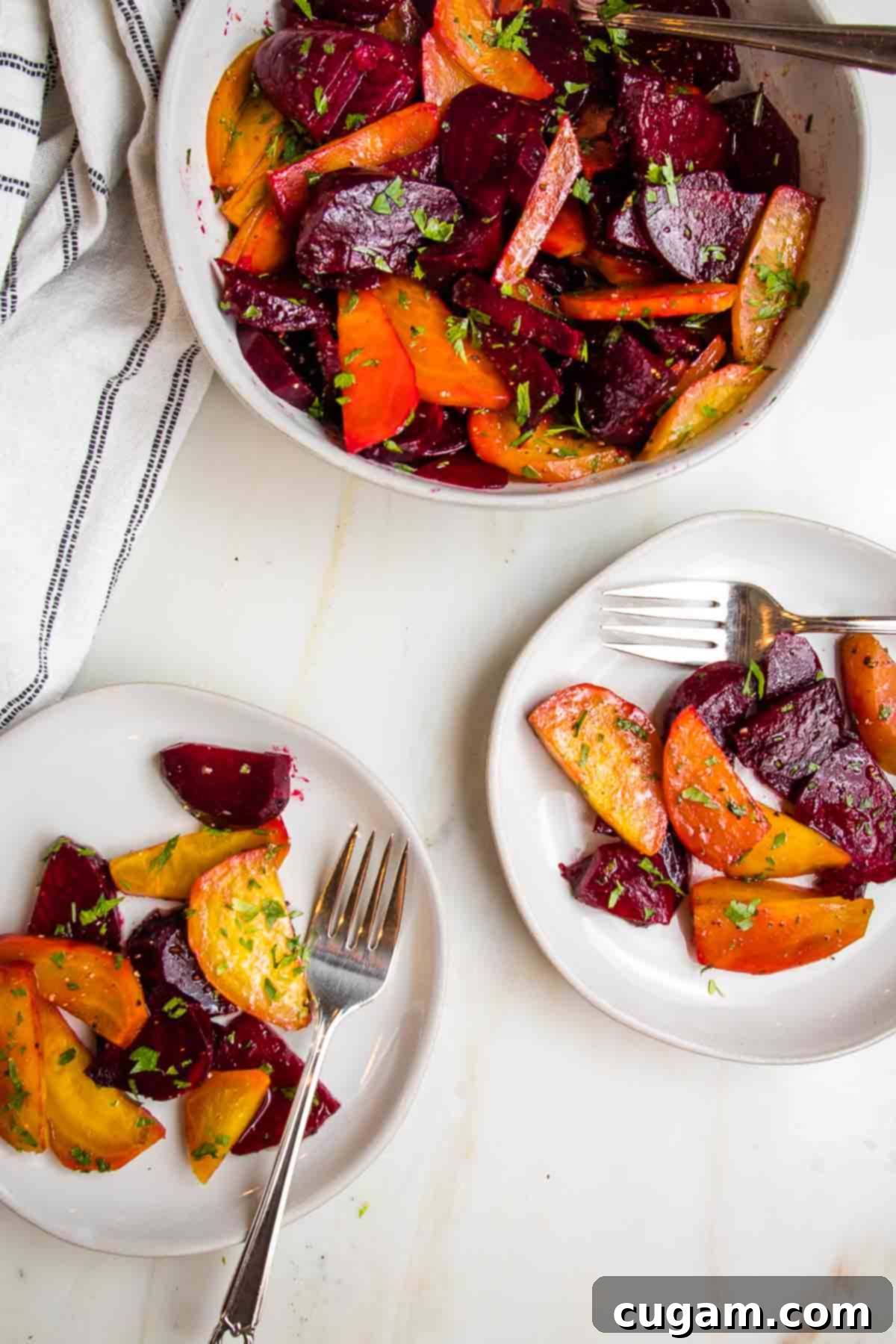
- Don’t Waste Those Beet Greens! Beet greens and their stems are incredibly nutritious and cook up quickly. To prepare them, first sauté the chopped stems in a bit of olive oil with some crushed garlic and a sprinkle of sea salt until they begin to soften. Then, add the beet greens, turn off the heat, and simply allow them to barely wilt. They make a fantastic, healthy side dish on their own or can be added to other recipes.
- Create a Stunning Presentation: For a truly eye-catching roasted beet salad, always use a combination of both golden beets and red beets. The contrast in colors makes the dish visually appealing and adds an extra layer of gourmet flair.
- Cleaning Beetroot Stains: Beet juice can be stubborn! To effectively remove beet root stains from a wooden cutting board, generously sprinkle the stained area with kosher salt and then scrub it vigorously with half a lemon. The abrasive salt combined with the lemon’s acidity works wonders.
- MESSY PAN CLEAN UP Made Easy: If your Dutch oven or baking pan looks anything like the one in my photos after roasting beets (with caramelized, sticky residue), don’t fret! Cleaning is simpler than you think. Use a chain link scrubber with a little hot water, and the residue will come right off with minimal effort. Another effective method is to boil a bit of water with a sprinkle of baking soda in the pan; let it simmer for a few minutes, then use a sponge to wipe it clean – the residue will lift easily.
More Root Vegetable Recipes to Explore:
- Lentil Salad with Roasted Vegetables
- Whole Roasted Carrots with Tahini Sauce
- Balsamic Roasted Root Vegetables
- Easy Tzimmes Recipe with Carrots and Sweet Potatoes
Did you know commenting and rating recipes is one of the best ways to support your favorite food bloggers? If you made this recipe, please consider leaving a five-star rating below and a comment sharing your experience. Also, we’d love to see your beautiful creations! Please share your photos on Instagram by tagging me @dkhealthcoach and using the hashtag #debraklein. Your support means the world!
📖 Recipe
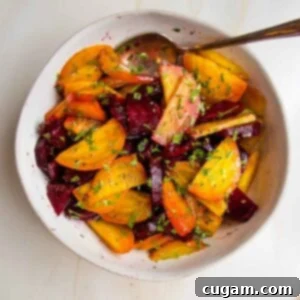
Whole Roasted Beets with Vinaigrette
Equipment
- Instant Pot
- Dutch Oven
- Extra Large Bamboo Cutting Board
- Global 3″ Paring Knife
Ingredients
Ingredients:
- 1 ½ lbs. beets trimmed
- 2 Tablespoons olive oil
- 2 teaspoons balsamic vinegar
- 1 teaspoon white vinegar
- ¼ teaspoon coarse sea salt
- ¼ teaspoon freshly ground black pepper
- 1 Tablespoon fresh parsley minced
Instructions
- Preheat oven to 425°F (220°C), unless you are using the instant pot method.
- Thoroughly wash and trim your beets, leaving about 1 inch of the stem attached and trimming the root end slightly so they sit flat.
Instant Pot Method
- Insert the rack into your Instant Pot. Place the trimmed beets onto the rack. Add 1 cup of water to the pot (below the rack). Seal the valve. Set on high pressure for 20 minutes for medium beets. For smaller beets, set for 17 minutes, and larger beets will need about 25 minutes. Use quick release.
Oven Roasting Method
- Place trimmed beets in a Dutch oven or a ceramic/glass baking dish. Add ½ inch of water to the bottom of the dish. Cover tightly with the lid (for Dutch oven) or with a damp piece of parchment paper followed by tightly sealed aluminum foil (for baking dish). Bake medium-sized beets for 1 hour; for larger beets, roast for 1 hour and 20 minutes.
- Beets are fully cooked and tender when they can be easily pierced with a fork or a small knife.
- When the beets are cool enough to handle, gently rub off their skins. You can use a paper towel or a small knife. Wearing a glove will help prevent your hands from turning red.
Notes
- SERVE: This roasted beet salad can be served warm, cold, or at room temperature. It’s fantastic on its own, tossed with fresh salad greens, incorporated into homemade hummus, or as a simple yet elegant side dish for almost any main course.
- PREP AHEAD: To save time, roast the beets whole in advance. Once cooled, store them unpeeled in an airtight container in the fridge for up to one week. When ready to prepare the salad, simply peel, slice, and dress!
- STORE: Leftover roasted beetroot salad can be stored in an airtight container in the fridge for up to a week. If serving again after a few days, a sprinkle of additional fresh chopped parsley can help freshen up its appearance and flavor.
- FREEZE: Whole roasted beets freeze beautifully for up to 3 months. After roasting and cooling, you can either wrap them individually in unbleached parchment paper and then aluminum foil, or place them in freezer-safe bags. Thaw in the fridge before peeling and using in your salad or other recipes.
Nutrition
Note
The nutrition calculations were done using online tools. To obtain the most accurate representation of the nutritional information in any given recipe, you should calculate the nutritional information with the actual ingredients you used. You are ultimately responsible for ensuring that any nutritional information is accurate, complete and useful.
